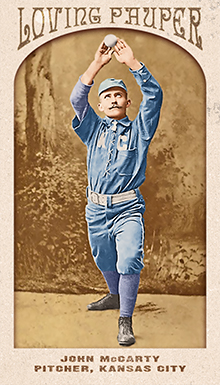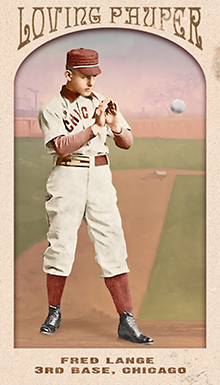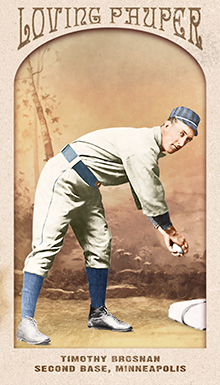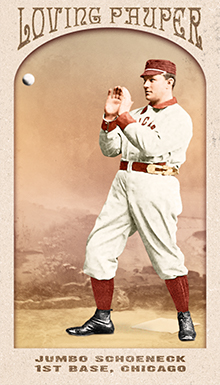
- Series: 1880s: Loving Paupers
- City: Kansas City
- Team: Blues (WA)
- League: Western Association
John A. McCarty (1867-1942) pitched in professional baseball for five years with one season in the majors. McCarty began at age 20 with the Emporia Reds of the Western League, starting eight games (tied for the most on the team that brief stint) and losing six despite a team-leading 2.92 ERA. He moved to the WL’s Kansas City Cowboys later in the year and went 3-2 on a large roster led by Kid Nichols who starred in his first professional season with an 18-12 record. The following year KC joined the Western Association as the Blues. They clearly liked what they had seen in ‘87 and retained McCarty for the ‘88 campaign. The young hurler rewarded the franchise with an excellent year, winning 21 games against 11 losses with a 2.42 ERA. Despite the 21 wins, Kid Nichols outshone McCarty again, winning 16 of his 18 games pitched with a remarkable 1.14 ERA. True to its decade, with leagues evolving and franchises morphing, 1889 found McCarty with a major league team without changing his address. He now pitched for the Kansas City Cowboys of the American Association. Unfortunately for John and his team, genuine big league competition exposed good minor league players. Nichols was in Omaha pitching to a 39-8 record, the Cowboys sank to seventh in the league and McCarty saw limited duty in just 15 games, winning eight and losing six with a 3.91 ERA in his lone major league campaign. He was demoted to the WA’s St. Joseph Clay Eaters for the remainder of ‘89 where he did start 15 games, but won only five. He had one more try with the Detroit Wolverines in their International Association incarnation in 1890, achieving a 9-9 record in a truncated season.
- BaseballReference.com records McCarty was on the roster for the 1891 KC Blues of the WA, but he appeared in only one game, giving up twelve hits and eight runs (two earned) in six innings and earning a no decision
Auction History
Cartophilia
Old Judge Pose: 302-3

- Series: 1880s: Loving Paupers
- City: Chicago
- Team: Maroons
- League: Western Association
Frederick W. Lange began his pro ball career as a teenager (how young is in dispute). He was from the San Francisco Bay Area and played in 1886 for the Greenhood and Morans team of oakland, a charter member of the California State League. The owners were haberdashers in Oakland who sponsored the club for three years. In 1887 the team floundered in last place despite having a lot of talent. The loss of star pitcher George Van Haltren, who went east to begin a long major league career, was a big blow. Fred Lange was a pal of Van Haltren’s and followed him to NY.
There is a fair degree of uncertainty and confusion surrounding Lange’s career, some of which appears to have been instigated by Lange himself. He had changed his surname to "Dolan" to sign with the G & Ms in Oakland so his parents wouldn’t know of his unworthy occupational choice. (Anyone familiar with the American Association’s reputation as the “beer and whiskey league” can sympathize with Fred’s folks as the 1880s were an era of free-wheeling debauchery in big time baseball.) But there is a reference by authors Dick Dobbins and Jon Twichell in their book Nuggets on the Diamond:Professional Baseball in the Bay Area from the Gold Rush to the Present, published in 1994, to the effect that Fred Lange was also “Willard Brown,” who went on to play for the NY Giants after leaving Oakland in 1886. Catcher William "California" Brown did play for the Giants from 1887-1889 and, perhaps not coincidentally, had played for Greenhood and Morans as well. Adding to the confusion, the editors of The Photographic Baseball Cards of Goodwin & Co mistakenly list William Brown as "Willard" in that seminal encyclopedia on the Old Judge universe. One possible theory to the confusion, however unlikely, is still intriguing: In moving East to pursue his big league dreams, might Fred Lange have adopted the name "Willard Brown" as a sort of hopeful and opportunistic nominal doppelganger to William Brown?
The truth is, most likely, that the mystery and confusion around Fred Lange's name and identity is the result of a more modern human error and that there is no mystery at all. Fred Lange & William Brown are clearly different people, perhaps even friends, who look nothing alike and appear together in a Greenhood & Morans team photo from 1886, thereby dispelling the notion that Brown was Lange's alter ego. Furthermore, there is no record of a "Willard Brown" playing professional baseball in the 19th century and the Old Judge folks were unconfused on the players' identities, with each player getting five unique poses in the series with no misspellings, overlay or confusion between them. Given that Van Haltren knew both Lange and Brown and that Van Haltren and Brown had quickly established themselves as bone fide big leaguers, it seems unlikely that Lange would attempt to perpetrate such a thinly veiled con while striving to join his friends on the big stage.
- Further adding to the confusion around Lange's name, the New York Metropolitan Museum of Art mistakenly lists Lange as "Lance" for the two Old Judge cards of Lange that reside in the museum's collection.
- Lange later authored an influential tome of his own: History of Baseball in California and Pacific Coast Leagues (1847-1938)
Auction History
Cartophilia
Old Judge Pose: 272-4

- Series: Beginnings: 1880's
- City: Chicago
- Team: Maroons
- League: Western Association
George Brinton McClellan Rooks (nee Ruckser) (1863-1935) had a vanishingly brief stint in the National League, seeing action in five games in left field for the Boston Beaneaters in May of 1891. He had a grand total of 20 plate appearances with 16 official at bats. He had twice as many walks as hits and ended his tour in the majors with a .125 average. He did score a run, allowing him to approach home plate from an alternate direction. This sketch doesn't do justice to a much longer professional experience for the young Chicagoan who had debuted with the Lincoln Tree Planters of the Western League in 1886 before moving on to the Northwestern League's Oshkosh franchise to finish the season. George remained in the league the following year with the LaCrosse Freezers where he was a regular. He hit .333, higher than any teammate with as many at bats. He showed both power and speed with four home runs and 70 stolen bases. Rooks got a cup of coffee in '88 with his hometown Maroons but got into only eight games before being shipped out to the Lima Lushers of the Tri-State League. 1889 would be the second and last time George played an entire season for one team, this time with the Detroit Wolverines of the International League. He was one of four to play 112 games and he produced a fine .303 average, second on the club among regulars.
- Following his sojourn in Boston, Rooks finished out his minor league career primarily close to home with clubs in Wisconsin and Michigan, including the intriguing bi-city squad from Ishpeming-Negaunee in 1892
- George strayed south for his swan song in '93 with Vicksburg of the Mississippi State League
- Although Baseball Reference data list George as right-handed, the Old Judge poses when he was with the Maroons depict a lefty both at bat and throwing

- Series: 1880s: Loving Paupers
- City: Minneapolis
- Team: Millers
- League: Western Association
Timothy J. Brosnan spent his entire professional baseball career in the minors, primarily as a second baseman. His first recorded teams, in 1884, were Springfield of the Massachusetts State Association and Rockville of the Connecticut State League. He moved to Lawrence of the Eastern New England League in '85 and also played for Brockton of the New England League. He was moving up in class at Lawrence where ten of his sixteen known teammates would see action in the majors. His stint at Brockton put Brosnan into even more elite company. Bill McGunnigle, who would go on to a managerial role in Brooklyn, was a pitcher/outfielder and Tommy Bond, then on the downside of a fine career in Boston, was a Brockton mainstay in the pitcher's box. In all, nearly two dozen of the '86 squad had been or would be big leaguers. 1886 was a significant dividing line in Tim's pro tenure. He left New England for the Southern Association's Charleston club. He played in the most games of any on the Seagulls despite a struggling .228 average. The following year saw Brosnan move to the midwest where he would conclude his professional endeavors. Tim joined the Des Moines Hawkeyes for the '87 campaign and again proved his durability, leading the team with 123 games played and compiling a very fine .317 average. With the Minneapolis Millers in '88 Brosnan's average declined to .254 but he was a regular. Tim's final move took him to Sioux City later that season and he would remain a Corn Husker for the final two years of his career.
- Brosnan hit .275 in '89, his last full year
- Tim was captured by the Old Judge crew in 1888 in his Millers' uniform — six poses depicting a right-hander at bat and afield
Auction History
Cartophilia
Old Judge Pose: 41-2

- Series: 1880s: Loving Paupers
- City: Chicago
- Team: Maroons
- League: Western Association
Lewis N. Schoeneck (1862-1930) came by his nickname honestly, standing 6'2” and 223 lbs, a true Gargantua in his day. Despite his size and presumed strength, Schoeneck proved better suited to the minors than the big leagues. His decade in pro ball was mostly in those smaller circuits and, apart from his season with the Union Association in which he played for two clubs and saw pitching a decided cut below true major league caliber, his batting average was consistently much higher in the minors. This is, of course, not unique by any means and the big first baseman was able to perform very well for most of the franchises he played for. Thanks to the renegade UA that siphoned off a lot of upper-tier minor league talent to make its attack on National League dominance in 1884, many of its players enjoyed one sunny season hitting well above their pay grade. Jumbo, for example, was in the top ten in the league in many offensive categories, including BA, OBP and Slugging Percentage. Since his only other major league time came four years later with the Indianapolis Hoosiers of the NL, his summer of love with the Pittsburgh Stogies and Baltimore Monumentals (never mentioned in connection with baseball greatness) enabled Schoeneck to “retire” with a career major league batting average of .283. Not a bad accomplishment to tell the grandkids.
- During his first of two seasons with the Hoosiers in 1888, Jumbo was summoned to relieve in two games. He hurled 4.1 innings, surrendering five hits and four runs without a decision. All of the runs were unearned giving him a phenomenal career ERA
- Neither of Jumbo's UA clubs performed too badly, but all of the league's other teams were crushed by the St. Louis Maroons who made mincemeat of the competition. The lop-sidedness of the runaway Maroon steamroller played a large part in demoralizing the fans and leading to the league's demise after that storied '84 campaign. St. Louis was a big winner in another, more important way. Their achievement led to the franchise graduating to the NL in 1885 where they became cellar-dwellers
Auction History
Cartophilia
Old Judge Pose: 404-4




